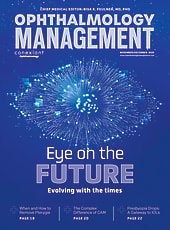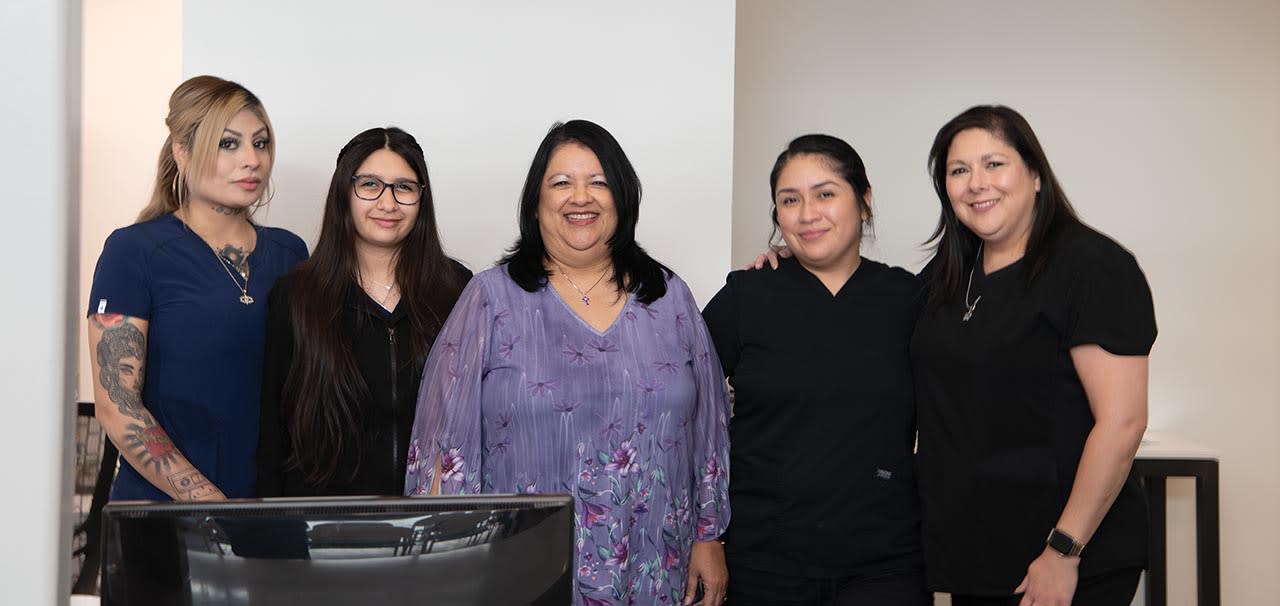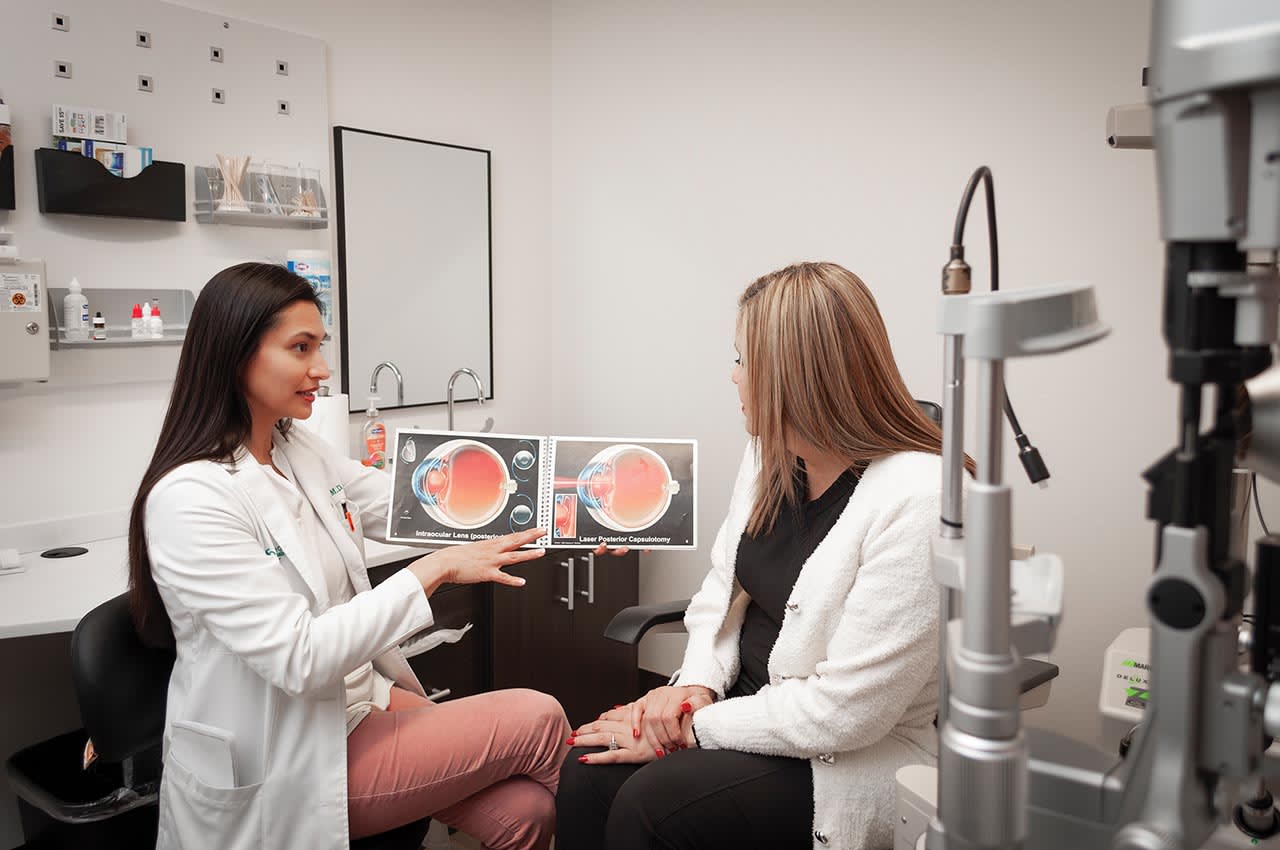One of the more exciting technological advances in ophthalmology over the last 3 decades has been the progressive improvement of IOL implant design. In the past, patients received a standard monofocal IOL and routinely required glasses after cataract surgery. Today, numerous IOLs are available, giving patients more freedom and independence from glasses after surgery. At Stone Oak Ophthalmology Center, we strive to provide an environment in which patients fully understand their options and feel confident with their IOL choices.
Our process begins with the initial cataract consultation with one of our surgeons. Our doctors typically spend 20 to 30 minutes explaining the surgery and IOL options in the exam room with the patient. The patient is then sent home with a “cataract folder,” written by our surgeons, to help him/her understand and digest the options presented at the consultation visit. We share a link to a video created by one of our surgeons, fully detailing the cataract surgery process and IOL options. Our patients have told us that they enjoy having this video as a reinforcement of the office visit discussion.
We then have a senior technician, dedicated to patient education, who schedules a 30 to 45 minute call with the patient to review what the patient has learned through the consultation, the cataract folder and the video. This is a wonderful question-and-answer session that we have found greatly increases patient comprehension of the surgery process and helps facilitate IOL choice. (See “The Ophthalmic Technician in the Role of Surgical Educator”) The patient has a third point-of-contact at the preop visit, at which time the patient meets with a technician for preop measurements and has an opportunity to ask any additional questions.
When presenting IOL options to the patient, we tailor the discussion to the individual. Patients with advanced macular degeneration or glaucoma will not be good candidates for all the IOL implants. Patients with healthy eyes usually have more options. We review any ocular pathology with the patient and discuss potential limitations in the vision after cataract surgery. The initial discussion with the patient is with one of our doctors and then our technicians (See sidebar, "How Stone Oak Ophthalmology Ophthalmic Staff Assist in IOL Selection" by Sergina M. Flaherty, COMT, OSC, CTC, (F)ATPO).
The sheer number of IOL options can be daunting to patients, so we break up the IOLs into 3 basic categories: monofocal IOL (either standard or toric), multifocal IOL and Light Adjustable Lens (LAL; RxSight).
How Stone Oak Ophthalmology Ophthalmic Staff Assist in IOL Selection
By Sergina M. Flaherty, COMT, OSC, CTC, (F)ATPO
At Stone Oak Ophthalmology Center, our preop technicians are experienced in preparing our patients for preoperative evaluations, ensuring accurate and reliable results. These technicians are highly trained and certified by the International Joint Commission on Allied Health Personnel in Ophthalmology (IJCAHPO). We strive to promote those who pursue IJCAHPO certification to this critical position.
In addition, we provide in-house educational opportunities and support for attending local, state, and national meetings to keep our ophthalmic technicians and other support staff well-informed.
In our practice, technicians are tasked to advise patients to refrain from wearing contact lenses for at least 3 days for soft lens wearers and 3 weeks for our rigid gas-permeable lens wearers before their preoperative evaluations. Discontinuation of contact lens wear is crucial to prevent skewed keratometry measurements and ocular surface readings.
The technician’s understanding of the patient’s history is also essential. It is important that they note any history of trauma, current medications like tamsulosin (Flomax) for benign prostate hypertrophy, which might indicate a risk of floppy iris syndrome, and other relevant conditions that could affect surgery.
Patients come to the preop after watching the video and reading about the IOLs we offer. We discuss the pros and cons and why they would/would not be a candidate for each IOL. We focus on expected outcomes rather than technical specifications—leaning heavily on the patient’s visual needs, what is in their best interest and ensuring they have realistic expectations.
By utilizing Certified Ophthalmic Technicians, we ensure that our patients receive exceptional care throughout their cataract surgery journey. Our staff are empowered to effectively support our patients—from preoperative evaluations through postoperative care—and they assist in the critical decision-making process of IOL selection.
At Stone Oak Ophthalmology Center, we strive to achieve the best outcomes and enhance the overall patient experience.
Understanding Their Options
Monofocal IOLs
Monofocal IOLs have one focal point and can be targeted for either distance or near. If a patient does not have significant corneal astigmatism, many patients enjoy excellent uncorrected vision for distance and use readers for near activities. These lenses are a great choice for patients who enjoy wearing glasses, those who have ocular pathology that may limit vision after cataract surgery, and those who are happy to wear reading glasses for near tasks. All insurances include the standard monofocal IOL in the cataract surgery reimbursement, so there is no additional cost to the patient with this lens. If a patient has significant corneal astigmatism, a monofocal toric is an option. Distance vision is excellent uncorrected and readers are needed for near activities. Toric IOLs, and the remaining IOLs we discuss below, are considered advanced technology IOLs (ATIOLs) and are not covered by insurance; patients pay an additional fee for this lens.
Multifocal IOLs
Multifocal IOLs have existed for several decades but have undergone many changes to improve the subjective and objective visual acuity and decrease the side effects. By definition, multifocal lenses have multiple focal points, giving the patient more freedom from glasses. This is usually accomplished by using concentric diffractive rings in the IOL. There are many different iterations of this concept.
In our practice, we have had best outcomes with the PanOptix (Alcon) and the newest generation of multifocal IOLs, the Tecnis Odyssey (Johnson & Johnson Vision). We counsel our patients that no IOL will give them perfect vision at all focal points. Multifocal IOLs require good lighting for best vision, especially for reading and near tasks. Occasionally, patients will still need readers for very small print or in dim lighting. In addition, contrast sensitivity is diminished with multifocal IOLs.
The biggest side effect we review with patients is the starburst and/or halo effect around point sources of light (headlights, traffic lights) caused by the concentric rings in these IOLs. We do not recommend multifocal IOLs in patients who drive at night for a living (truck drivers, school bus drivers). However, for the healthy-eyed patient with no history of prior refractive surgery, who desires freedom from glasses for most activities, the multifocal IOL is a good choice.
In addition, we occasionally use the Tecnis Symfony OptiBlue (Johnson & Johnson Vision) and Vivity (Alcon) IOLs. These lenses are considered “extended depth of focus” or EDOF lenses (included in our “multifocal” category). They have fewer concentric rings, and, therefore, fewer issues with starbursts and halos compared to traditional multifocal IOLs. With these IOLs, the distance and intermediate vision is usually quite good, but readers are typically needed for near activities.
Light Adjustable Lens
The final category of IOLs in our discussion with our patients is the Light Adjustable Lens (LAL; RxSight). The LAL is the first IOL in which the optical power of the lens can be adjusted after cataract surgery. The lens material of the LAL is sensitive to UV light. Once the eye has healed from surgery, the surgeon utilizes a proprietary device (the Light Delivery Device, LDD) to adjust the power of the LAL based on the patient’s desired focal point. To achieve the most independence from glasses, a “blended vision” approach is needed. Like traditional monovision, the dominant eye is set for distance and the non-dominant eye is set for near. However, we have found that LALs tend to require less myopic targeting than traditional monofocals used for monovision. We see excellent intermediate and near vision with the non-dominant eye at a -0.75 or -1.00 final refractive error.
Because LALs do not have concentric rings, patients do not experience the starburst/halos often seen with multifocal IOLs. However, because blended vision is necessary for the most independence from glasses, we do not recommend these lenses in patients who have tried monovision in contacts and could not tolerate it. The postoperative process is prolonged with these lenses, so we counsel patients that they should plan on 2 months of postop visits rather than the typical 1 month. Once the eye is healed (around 1 month), we begin the LDD treatments.
The LAL can be adjusted 3 times, allowing the patient to “test drive” the vision in between treatments. This is a revolutionary concept, and we have enjoyed the ability to fine tune vision in a way that has never been possible before. LALs really shine in patients with a history of refractive surgery. This category of patients has always been challenging because they have high visual expectations but our current IOL formulae are not as accurate in post-refractive eyes. The ability to adjust the IOL in the postop period alleviates the stress of choosing the correct IOL power substantially. We also prefer the LAL to a multifocal in post-refractive patients because the corneal aberrations in post-refractive eyes tend to result in poorer image quality with multifocal IOLs.
Conclusion
We have found that reviewing the surgery process and IOL choices in this manner helps us be thorough and consistent with each patient. In our current internet era, with endless information at our fingertips, our patients often come to the visit having researched cataract surgery and IOL options. Many times, what they have discovered in their research results in even more confusion. We take our responsibility to educate patients in a clear and ethical way very seriously. Cataract surgery is a once-in-a-lifetime opportunity, and we want our patients to feel fully confident that they made the right choice.
It is an incredible time to be practicing in this amazing and innovative field. We look forward to what the future holds! OP















